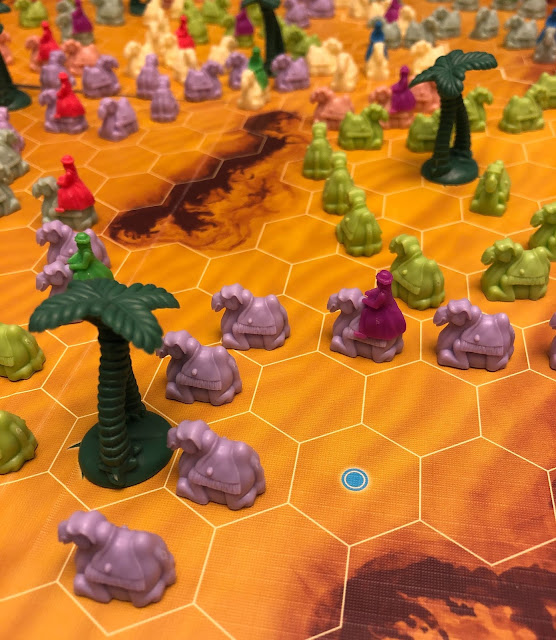Back in 2008, game designer Donald X. Vaccarino had a brilliant idea: "Hey, everyone loves collectible card games like Magic: The Gathering...why not design a game where you build your deck as you play? Whaaaaaaat?!?" The resulting game, Dominion, was an instant smash hit, but then, just one year later, Mike Elliot's Thunderstone came along and added an actual theme to the concept...a dungeon crawl no less!
And, with that, Dominion was deader than disco to me.
Just like in every other deck-builder, players start off with a handful of mediocre cards, which include pencil-necked adventurers armed with lame-ass weapons, as well as strength boosts to carry heavier stuff and light sources to delve deeper into the dungeon. Players also produce gold which can be used to, *surprise, surprise*, buy equipment and recruit hirelings from the Town Board's Marketplace and Guild's Quarter.
As these party members "level up" and start wielding increasingly-powerful equipment, players will look to "trim the fat" from their decks to create a lean, mean, monster-killin' machine. Naturally, the ultimate goal is to build an efficient engine that doesn't leave you sitting around polishing your longsword during any given turn.
I enjoyed Thunderstone Quest. The production design is fantastic and the art is breathtaking. Since you can typically plot your turn out well in advance, the game keeps chugging along at a nice clip. There's a ton of different weapons, equipment, characters, monsters and spells, which drives up the game's re-playability. Also: bonus point for linking the number of cards you draw to your current health and using poison cards to create dead spots in your hand until you heal.There's also a genuine visceral thrill going after powerful monsters, knowing that their impending death will yield tremendous rewards.
Victory points are so understated that I completely forgot about them and just spent every one of my turns getting ready to battle monsters or battling monsters(go figure). As a result, my final score sucked kobold balls (koballs?), despite an decent start and what I thought was a fair effort. Also, the co-operative final boss battle involves rolling dice to see what hirelings and equipment you'll lose in the fight. Naturally, given my Wheaton-esque proclivities with dice, I lost a bunch of random stuff right at the end.
I'd rank it a lot lower than A Few Acres of Snow, which I think is the perfect marriage between theme and mechanics. And even though the art in Clank! is vastly inferior, I still think like that one a shade better since moving around the board / exploring a maze does wonders for my immersion.
Thunderstone Quest rates four pips outta six with a big tilt up towards the top of dat Elven Outpost!
In Paper Tales, players secretly draft five cards, reveal them, pay their recruit cost, place once in reserve and then table the others. Two cards are placed in the front rank to battle against opponents sitting to the left and right while the remaining two are placed in the back rank to either support the front line or produce assorted resources.
Resources can be used to great production synergies between cards, create victory point engines and/ or construct buildings. The latter is great because they let you table more cards in future drafts, help bolster your troops, give you moar veeps and add to your resources. Basically the buildings help bolster your prevailing strategy.
At the end of a round, remaining characters get an "aging" token, sticking around for one more round before they "die", thus making room for new recruits. This mechanic alone requires some pretty deep planning, since new acquisitions will be taking over vacant slots and some even take advantage of the collective number of aging tokens on all of your cards.
This one has a lot going for it. Even though the building iconography is a tad muddy, the overall art style is whimsical and charming. The game is also surprisingly deep, requiring players to ponder through-line strategies and draft accordingly over the course of four rounds. Points gained from military wins are great, but if you ignore all other development then there's a really good chance that your l'il civilization will stagnate.
Paper Tales is a great choice for folks who have graduated beyond Sushi Go or they just don't wanna be bothered with a long and sterile-looking game like 7 Wonders. This is definitely one that'll have you agonizing over decisions and chomping at the bit to play again and again.
Four pips outta six with a mild tilt up out of the crystal-filled Mine!
***
Hey, folks! If you're enjoying these reviews, please consider buying me a Coffee! Full disclosure: I probably won't use the money to by java; it's much more likely I'll use it for frivolous stuff like heat and hot water. All the heat-related things. Hey, it is winter, after all!










